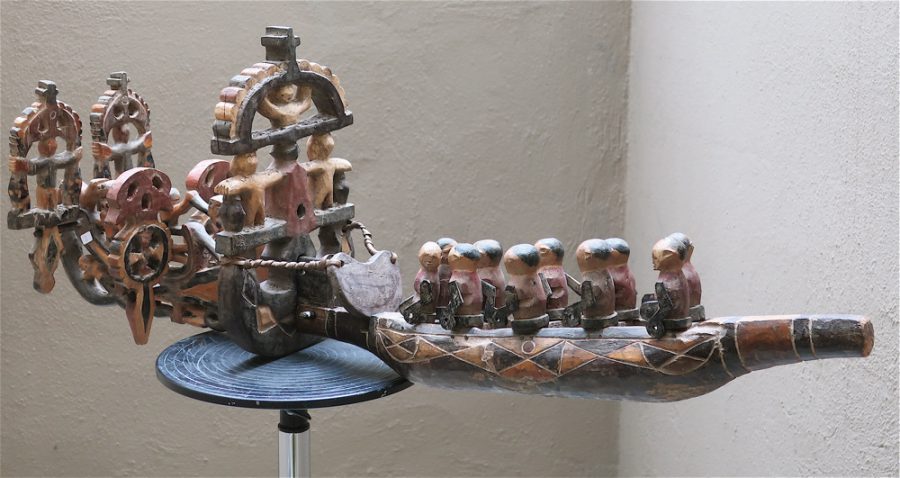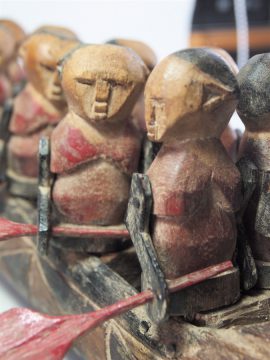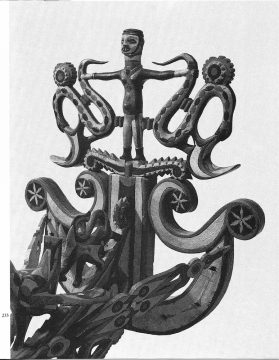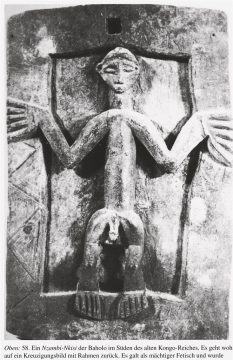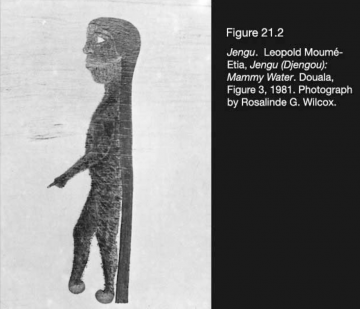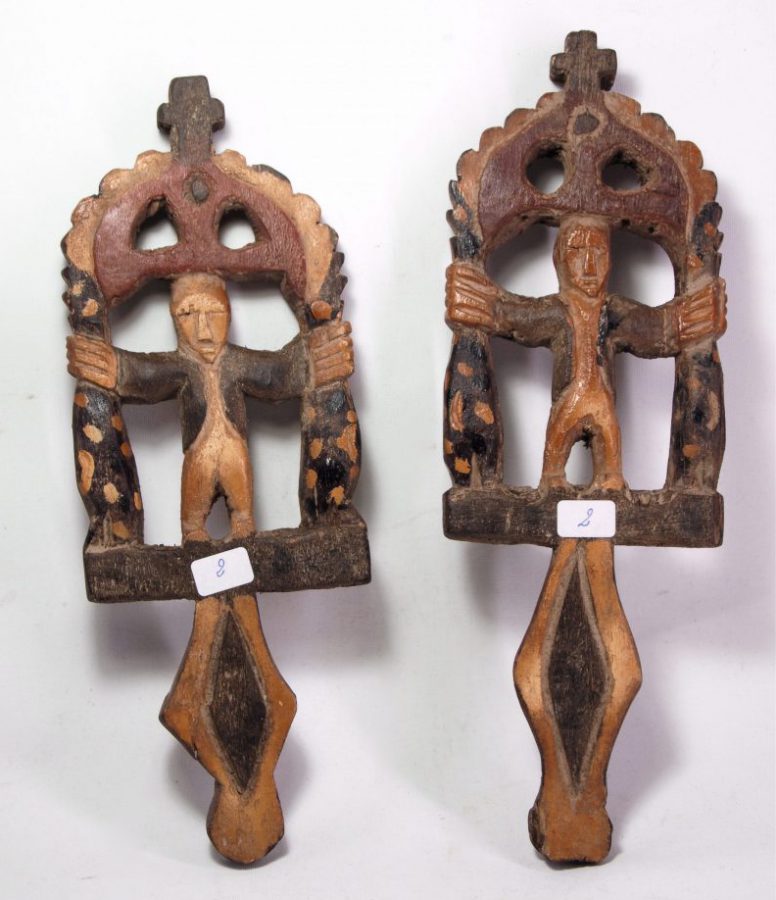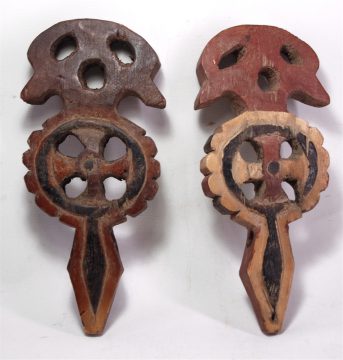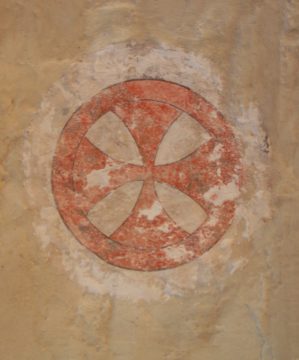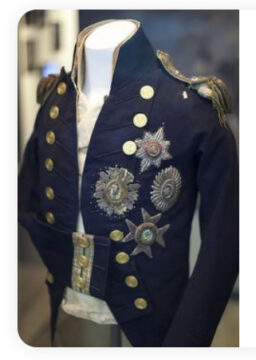For wider distribution, parts (2) and (3) of my first attempt a year ago are now available in English. I’m currently working on a sequel with additional sources and a slightly different perspective, but the earlier texts retain their introductory value.
v.Graeve February 26, 2021
In the original versions, a short history of the Douala in Cameroon – in the original German version LINK and the French version LINK – touches as part (1) on very different aspects: the natural conditions, the geopolitical situation since 1500, the economy of the Doula, the status of slaves, the history of colonization on the banks of the Wouri, the role of white merchants, missionaries and representatives of the colonial power since 1884, the consequences of Christianization and the post-colonial situation. I try to maintain the equidistance of the historian without getting involved in the conflict of ideological parties.
MY FIRST IMPRESSION
The one-meter-long boat miniature, you see in front of a white wall on a long trip to an unknown destination, is really complex, a two-part composition made up of many wooden pieces, and it is about a hundred years old. The rear half represents a canoe (pirogue) – indispensable means of transport in the Wouri delta – the front half recalls an ornamental beak attached to it during war, trade, and festive boat races. But in this miniature it is extremely enlarged and ”baroque“ in its symbolism. I am looking everywhere for a similar model, so far without success.*
- * THIS WAS RIGHT TILL JANUARY 2021. I AM WORKING ON THE SEQUEL!
STARTING POINT
“Douala in the Wouri Delta,” the merchant said, a persistent but patient and efficient young man from Brussels, whom we call Maurice. Back home, I received a first orientation from Maria Kecskési: “Kunst aus Afrika”, Prestel 1999:
“On festive occasions, boat parades and regattas took place – and continue to this day. For such festivities, the ships were (and are) decorated with long artistically carved beaks (tange) inspired by the figureheads of European merchant ships. The tange are rich in figures and decor and painted in bright colors. They use motifs from the lost traditional art of Douala. At the same time, many details testify to the intensity of the foreign influence. ” (p.90, Translation)
The „Museum 5 Kontinente“ in Munich has two carefully crafted beaks once owned by two rival noble clans; one beak was captured in an act of war in Douala in 1884 at Hickorytown from King Lock Priso, the other was purchased in 1889 from King Bell.
Then I search the keyword „Duala people“ in „en.wikipedia.com“ with historical and cultural information, with photos and other links. There I come across a very successful „canoe model with rowers from the colonial period between 1885 and 1914″ in the Tropenmuseum Amsterdam, which is presented in English (_TROPENMUSEUM_TMnr_6153-1a-1). I ‚ll see still more of them, for example in the Hanover catalogue “heikles erbe“ (=sensitive heritage). But this realistic model, reduced to five feet (1,50m), showing imperious colonial officers and the flag of the Deutsches Reich above the rowers, looks as if been manufactured only to special order for Europe. The Hanover „Heikles Erbe“ catalog confirms the hypothesis for its models.
A Beautiful Legend Arrives from Cameroon
Maurice quickly responds to my request to repeat his explanations in French, which I had only half understood.
Email November 14, 2019:
The inhabitants of the Wouri River made a living from fishing before and after their discovery by the Germans. The villagers experienced the arrival of the Germans in a large canoe, they made this canoe in memory of this discovery, because they had never seen a boat that was „dressed“ like the one in the photo. The canoe carries men in the moment of piloting. The first profile on the canoe symbolizes the first church built by the Germans. The Sawa people are 90% Christian and Sawa (Duala) are 90% Christian to this day. This is how the canoe comes into play among the Sawa Douala in Cameroon. (Translation)
The arrival of the Germans and their first church with resounding success of their mission – what a wonderful legend! In any case, it motivates me to study the history of Cameroon. Maybe the caption should flatter the potential buyer. Maurice knows his German clients. When he announced his departure for Cameroon a few weeks earlier, I assumed he was trying to speed up my decision. But as I see from his emails, he’s really arrived there. My good luck! I ask by email and get a response: “The canoe comes from the Djébalè chiefdom (… ..); the canoe remains to this day the only means of public transport between the village Djébalé and the city of Douala across the Wouri river. Djebale Island was discovered by the Germans in 1800. (….)
„Do you know Djébalè?“ (Jebalé)
Shortly after, I find online a report by Josiane Kouagheu under keyword „Djebalé“. She wrote on her blog in 2014:
„Do you know Djébalè? Ask this question to 100 Cameroonians, 98 will answer: „Uh, which district is it? „. Others will say to you: „Oh yes is that the little village somewhere there? „. Somewhere there no more. This is how they talk about the island of Djébalè, an expanse of land in the Wouri, one of the largest rivers in Cameroon. (…) How could they have forgotten such a village? One would be tempted to ask. That is, the island has not seen any development since the colonial period. It is a village inhabited by the Sawa people, the Douala as they are called here. It is above all a village lost in Douala … When the simple traveler wants to go to the island, he encounters difficulties in terms of transport. Apart from Saturday morning and evening, no canoe goes to Djébalè, except on rare occasions. The visitor therefore begins by looking for his „boatman“. A difficult problem to solve. Indeed, the boatman that we find makes a round trip. You have to pay the price! (more expensive for motorized canoe and less expensive for paddle canoe). After agreement, the journey can begin. The departure takes place on the banks of Bonassama, a district which adjoins Djébalè. 15 minutes later (if he has taken the motorized canoe), he sees in the distance the first houses on the island appear. Pure colonial style. Closer, he notices the faded walls and the roofs yellowed by the force of time, the first houses of Djébalè. And when the canoe docks, shacks, mostly built of temporary materials are visible. At the chiefdom (chefferie), the village chief, Isaac Dibobe welcomes you. “Welcome to Djébalè”, he tells you at the outset. And there, like a storyteller around the fire, Issac Dibobè, „His Majesty“, tells you the story of his island which saw him grow up more than half a century ago. “It was in 1800 that the Germans discovered Djébalè during their presence in Cameroon.” The name of the island goes back to the wife of the first black man to arrive on the scene. Legend has it that he was dating a mermaid woman named Djobalè, and he would have had several children with her. Hence the name Djébalè. Despite this wonderful story, the village is unhappy. „We have no drinking water, let alone electricity,“ explains chef Issac Dibobé, with tears in his eyes. The island’s only source of electrification is solar power. An insufficient device given the spacing of the houses.
The only school on the island is the Djébalè public school. After obtaining their Primary School Certificate (Cep), the young people will continue their studies elsewhere. Some never return, arguing that there is no „distraction on the island.“ Only the old men and fishermen remain in Djébalè. Their wives grow cassava, plantains and pumpkin seeds. Every Saturday, they go to the Bonassama market (200 F.CFA for transport) to sell their goods. The oil-rich soil is yet to be exploited. A few meters from the island, other districts of Douala live with water, electricity and schools. Djébalè seems to be the orphan of a mother who only loves „some of her children …
Name: Island of Djébalè Location: Arrondissement of Douala 4th Area: 80 hectares Population: 800 souls.» (Shortened Translation)
Jebalé is everywhere
It is not that important whether Maurice read everything on the net like me or heard it directly from the village chief. There will still be other reasons for that background of the boat model. “The point is, the island has not developed since colonial times.” It is bitterly poor and isolated. In 2016, the publication of the „Douala ô Mulema“ urban network reported on a major construction project due to heavy traffic in the east-west direction. Two new bridges over the Wouri were to be built. The second, planned since 1994, would cross Jebalé, which would mean an economic recovery for the island. But as the Google satellite image shows, nothing has happened so far. In „Die Augen meiner Ziege“(“The eyes of my goat”) , de Rosny reports on his apprenticeship with a traditional healer in Deido in the Eightees, whom he accompanies to a therapeutic session in a village across the river.
“We cross the Bepanda and Deido neighborhoods, where the lights are already off. We cross the eighteen hundred meter long bridge that spans the Wouri. To our left on the quays, ships shine with a magical light, to our right the dark silhouette of shores and islands. After crossing the Bonaberi district, we drive through the bush and are almost immediately in the village. (…) We are seven kilometers from our homes, but we are <in a foreign country> “. (68, Translation)
One of the following days, when de Rosny visited alone the village chief, who had impressed him, he was stopped at a makeshift roadblock by a group of uniformed teenagers. “United Boy Scouts”, as they can be seen at the official parades. “They are proud of their relationship with this great international movement and are determined to prevail against the village chief as guardians of a new order.” The situation was only resolved by the young vice-village chief after an hour of negotiations (79). De Rosny had a conversation with a scout and sums up his explanations. “There are a lot of young people here. Some live in Duala, but they return home on Sunday. The Chiefdom (chefferie) does nothing for development. We want the uprising. We make parents understand the reason.“(90) He wonders: „Will there be a dialogue between an energetic village chief and these young people who have not entered the modern world, but who are not yet ready to resume fishing and the canoe? This small village on the outskirts is part of the city and yet everything remains as if you were living in the countryside. Conflicts around the adaptation of cultures emerge strongly there.“ (90) By the way, adults immediately came to support the young scouts, because rumor had it that the “white priest” de Rosny was a magician and “bought people in the villages he visited„.
Jebale – privileged place for water spirits (Mengu, singular: Jengu)
“When the Duala and their loved ones arrived on the eerie and dismal coast centuries ago, they had to banish their fear of the man-eating sea and somehow control the uncertain gifts of it. ‚water. Here the mengu ruled the water world, ruled over fish, manatees and crabs, including raffia palms growing in the stream. „(de Rosny, 55) They are found in dangerous currents, on hidden rocks, waterfalls, thick bushes and shallows. Djebalé in the Wouri River or the Victoria Rocks are also considered their favorite places to stay because they are particularly dangerous. On Djebalé, you will find real experts in the Jengu cult. As with humans, the mengu of the interior are considered the weakest, and those of the sea as stronger than those of the rivers. (55) They dominate storms, set off tornadoes, and when the sea is still, they are busy with people. (56) The appearance of a merchant ship is attributed to them (78). This was especially true for the pre-colonial period. Since these beings show extraordinary adaptability, humans must behave in complex and wise ways. When capsized boats and their goods float in the water, it means that mengu are storing them where they are. Personal mengu as „guardian angels“ avenge disobedience to drowning or hours of obsession. (56) Obsession might prompt a person enter the Jengu League (63), but only if the wealth was sufficient, (65,73) as the cult served for social segregation between the aristocracy and the slaves (72). The Duala claim to be descendants of the mengu, with whom they even have sex. (64)
Among the mengu rites of fishermen, the Ngondo festival is explicitly mentioned – in a new form since 1949 – in which canoe regattas are held in the river in front of Deido and of Jebale. Today, the cult connects related coastal tribes. (64)
Rumors about Jebalé (Djebalé)
In the eighty years of – colonial – domination of Christianity, when the traditional means of acquiring <force> fell into oblivion and the <medicine-men> who had them became socially marginalized and became invisible (René Bureau, 33 ), Jebalé sticked to it. Is was some sort of „Gallic village“ of Asterix and Obelix?
Jebalé is mentioned several times. Two examples:
Under the title „Nyungu, the serpent of calamity„, de Rosny writes: “On the small island of Jebale, which begins opposite the neighborhood we live in, no wells are dug for fear of nyungu. Several people told me, including Jacques Mudiki, professor at Jebale, and Simon Musinga, fisherman. The Nyungu is assigned properties of the Boa, which still penetrates into the cities today. But it’s an invisible boa. And again on Jebale, some people’s belief is so strong that they don’t even dig a latrine. Because there the enemy (the magician, sorcerer) would send the nyungu to drink the blood of a woman and prevent her child from being born. This example shows how the mention of this serpent can inspire the imagination. Each nganga (healer) has his own method of hunting nyungu. „(50)
De Rosny discusses the 1971 cholera epidemic with Loe, a healing friend in Duala: (72f.)
ENTRY ON STAGE OF „SMS OLGA“ AS POINT OF REFERENCE
(hypothesis perhaps too daring? 02-2020)
I come across the illustration of ‚SMS Olga‘ of the Reichsmarine on wikipédia.de. First under the name of the gunship, then under the keyword “Kanonenbootpolitik” (gunship policy). I would imagine a modern warship differently, not as a sailboat with three masts and two low chimneys. The <platform corvette> was put into service not until 1881. However, Wikipedia mentions quick model changes afterwards. The illustration from the German magazine „Gartenlaube“ shows four modern landing crafts too.

Model of a «Gouvernementsboot», l’exposition «heikles erbe» n° 146 à Hanovre
How did Maurice formulate it (see „Beautiful legend“ above)?
„The inhabitants of the Wouri River made a living from fishing before and after their discovery by the Germans. The villagers experienced the arrival of the Germans in a large canoe, they made this canoe in memory of this discovery, because they had never seen a boat that was „dressed“ like that.“ Around a quasi-lagoon where a warship would have entered only to be refueled or repaired (as „MS Dido“ 1841), the start of the German „Gunboat Policy“ with artillery fire was impressive: Fire in the residence of King Lock Priso and Hickorytown (Bonaberi), some dead and many injured, the majority of the population fled into the bush. From Jebale, which lies opposite, explosions and fires could be seen. We see in the foreground of the engraving a traditional war canoe: the warriors of the Bell or Akwa clan who approved the protection contract. They are about to loot Hickory Town together with the Germans. Traditional weapons have long been anachronistic for the Douala (Heßler 1896, 80). Another newspaper illustration also shows muzzle flashes on both sides as the Marines storm the Joss Plateau occupied by Lock Priso. However, one needs no guns to loot an abandoned village.
If you take a closer look, can you imagine the gunboat taking the canoe in tow the very next moment, as is the case with the model? The expression „arrival of the Germans“ corresponds to this experience. I also have an explanation for dating „1800“, first, a mixture of different events, and second My experience with interlocutors in Germany on historical topics : One or two centuries are often absent from their imagination.
I would like to stop here on the general impression.
The third part of the essay consists of a detailed description of my canoe model and its preliminary interpretation. ( LINK to French and LInk to German versions).
(3) – Description et interprétation of the Canoe Model
Heraldic competition:
The commercial flag of the German Empire with an allegorical decoration on the beak of the boat – and at the stern the even larger flag of King Akwa. Under the parasol sits a dignitary dressed in white, a representative of the Woermann trading house? For what occasion? The decoration of the canoe certainly responds to the wish of the „king“ Akwa for a strong representation in competition with the German Empire.
The woodcut illustration adorns an 18-page article on „The Colonial Aspirations of Germany. The Germans on the West Coast of Africa „in„ Gartenlaube: Illustriertes Familienblatt, vol. XXXII, n ° 37, which is modest in its colonial aspirations and justifies them on a purely commercial basis. (LINK, in German)
The Hanover Duala canoe model (circa 1900)
In a special chapter the catalogue “heikles erbe” (Hannover 2016, “delicate heritage”) examines the various „appropriation practices“ under German colonial rule in Cameroon (pp. 199-211). Not all of them were „illegitimate.“ The colonized also had options for action, which they often used intelligently. This is how the ethnographic markets for handcrafted decorative items came into being during the 19th century. “Another example of tailor-made products for colonial travelers are many boat models that are now kept in European museums. ( I’ll go into more detail in the sequel.) Encouraged by contact with Europeans, they were „made as gifts for Europeans returning home, as a sign of the good trade relations that had existed since the 17th century“. (209)
The Hanover model shows in simplified form an attached beak (tange) and its attachment. Rowers are arranged dynamically. High quality craftsmanship! Above all, a larger front view in the catalog proves the sophisticated, but also schematic carpentry work. Figures and oars are evenly coated with black-brown lacquer. Fresh condition! The remark “Wissmann Collection, kept in exchange with the Museum für Völkerkunde Berlin” leaves questions open. „Before 1914“, but when purchased in Duala? 1884. (email fevr. 2021)
Hypothesis: My boat comes from the conservative periphery of Duala
The model I own looks like the work of a rural canoe maker. An openwork relief of unspectacular quality, without sophisticated carpentry technology. The gaps were pierced with a small chisel, the accompanying line made with a gouge. As product of the conservative periphery, it is a unique production, to be compared with ‚our‘ Tyrolean cribs of the Nativity. The figures are produced separately, but by the artist who also modeled the thick-walled canoe and added hand notch designs typical for the Douala. Are only rudders and flexibly nailed arms purchased as “in-house” parts?
In the catalog „Kunst des alten Afrika“ (1982) Maria Kecskésy mentions the wood art of western Cameroon: “Characteristic is – both in the round sculpture and in the high reliefs – a certain type of representation of people: flowing lines, slightly curved legs, curved in the shape of a tube…. The long, narrow head is usually without a hairstyle, the concave heart-shaped face is reduced to the essential, the eyes are sculpted in the shape of a button or almond; The flat nose and the open mouth with protruding lips are characteristic ”. (232-233, Translation) “
Features: clothing, skin color, fighting motif, snake, bird, eye
In her 1982 description, Maria Kecskésy classifies European clothing as „the only detail that clearly indicates a European influence„. She rightly interprets it as a function of the highlighted status. (See also the portrait photos in the „Gartenlaube“). White skin, on the other hand, matches local traditions as a cult color. Other features have their parallels mainly in the Near East, they migrated. For example, the circular ornament and rosette: „On boats, it could be a variant of <oculi>, for the defense of the evil eye with which so many ships in the Mediterranean and the Indian Ocean are equipped.“ The man holding a twisting serpent in both hands is said to symbolize „benevolent cosmic powers“ in the ancient East. The motif of bird and serpent fighting first appeared in Babylonia 3,000 years ago and migrated to Egypt, for example. The motive had taken on different meanings of hostility: fight between light and darkness, celestial and subterranean powers, good and evil, its own dynasty and its enemy. Kecskésy sees – as Wilcox does – in the cultures of the Guinean Coast – Baule, Achanti, Yoruba, Benin etc., with which the Wouri delta has been associated for a long time (n ° 235, p. 222f)) – intermediate stations.
 (R.Wilcox: «Mamiwatas ..» dans «Sacred Waters» Indianapolis – owned by King Lock Priso; M. Buchner’s spoils of war Dec. 1884
(R.Wilcox: «Mamiwatas ..» dans «Sacred Waters» Indianapolis – owned by King Lock Priso; M. Buchner’s spoils of war Dec. 1884
However close the two heraldic sets are, that of Lock Priso (fig. 21.3) is undoubtedly more political, more selfconfident, more interesting in terms of content. Kecskésy rightly points out the appropriate motives: “The leader, tamer and elephant killer” holds a gun, but kills with the spear. And „under the idyllic image of a small table with a bottle of brandy and glasses, between two kerosene lamps a cannon tube sticks out aimed at the elephant killer.“ Dual strategy„. (p.225) Lock Priso knew the Europeans well. It was not without reason that in 1884 he pleaded for the English “protectorate”. He knew from experience what to expect.
The realistic style of the two „royal“ tanges is extremely valuable in deciphering the humble version that I have acquired. With patient observation, all of its traditional patterns can be identified, as quotation, not worked out creatively!
Detailed Analysis of my Boat Model of Jebalé
The tange occupies about forty percent of the total length! It consists of six wedged components, not longer than 60 cm (23,2 inch), presumably for safe storage in a basket. First, I remove the split pin connecting the two parts, then I unclip the leather buckle and dismantle the „baroque“ attachment. We first consider its longitudinal axis, because it represents the traditional „core“ with the symbols of the Munich Tange. We then turn to the three rows of cross bars on the longitudinal axis. They immediately catch the eye and give the construction its interesting character. The disconnected canoe is described last.
A traditional Douala imagery dominates the long axis of the Beak

Usually the view of these scenes is partially obscured by the elements attached to it at right angles. Two of the cones for fastening can be seen in the photo above. The central figure, a chief with outstretched arms even has some part right in front of the nose. It was not taken into account when working on the various elements. The chief looks in the opposite direction to the other four human figures. Maurice describes them as „warriors dressed in European uniforms“, and as „the chieftaincy guard who accompany the chief to protect him „. This is clearly the inner aspect of traditional power or the responsibility for and defense of the community.The faces are white (“white cult colour”, ibid. p.225).
The gesture of power – four variations
A strong gesture of human domination is the spread or stretch of strong arms. The balance between dynamic energy and static equilibrium is not permanent. A black snake emerges from the water and prepares to devour the head of a large yellow bird, recognizable by its long beak and short body. With Kecskési no. 236 the motif is called: “Struggle between bird and snake”. A second small black-spotted snake bites into the bird’s abdomen. Three small human figures in black pants strive to hold monsters in an ever-threatening balance. The middle figure controls two predators. We can identify a dog or leopard by its curled tail and its triangular notched ears (cf. 1982, above no. 235). Does he bite the man in the hand? With the other hand the chief catches a snake, which is biting a bird in the tail. In a „psychological“ interpretation, the human figures give the impression of extreme exertion, if not overstrain. Of course, a simple quotation from these allegorical figures can only convey this to a limited extent.
The two Munich tange of the 19th and the advertising image of the 20th century embody the triumphant development of power in perfect balance. The 20th century advertising magician also easily masters two worlds, the visible and the invisible.
Kecskesy 1982: n ° 235 King Bell’s (détail) de Rosny «Les yeux de ma chèvre» p.180, 1996 Medical advertising brochure
What happened to the heroe with strong hands? – Dolls and Obsessions open the doors to the global networked art world.
WHAT DOES PASCALE MARTINE TAYOU SAY? THE ARTIST LIVES IN PARIS AND DOUALA > NO MORE AT GALLERIA CONTINUA / San Giminiano etc.
The relief of the Old Congo Empire interpreted by J.F. Thiel (“Jahre im Kongo“ Fig. 58, 2001 LINK) as Christ crucified, is formally interesting because of its frontality, its slanted arms and oversized hands in front of a wide frame. According to its function it is a symbol of power (Nkisi).
Slave in the Ship’s belly
The naked man does not correspond to the others, but is clearly placed in the center. It balances horizontally in a ship’s hull like in a wheel, perhaps due to the perspective from above. The ship is represented by its cross section.
What does the figure of „slave“ mean? First, an extremely profitable commodity in the past, comparable to elephant ivory (Tange # 235 King Bell), second, it could also symbolize the traditional basis of social order, and third, the determination of not to let the Europeans or the „Bamileke“ govern them. (part 1). Conversely, the motive may refer to an existential threat. Its place directly under the powerful “leader” could also meet its obligation of protection in the “second world” too. During the slave trade era, village chiefs handed over simple people to whites as middlemen for their own profit. Eric de Rosny regards the “slave trade” as a well-known model of collective memory, as modern wizards transfer people to another world for forced labor. (Keyword „Ekong“ in „The eye of my goat“ 85; 93 Note 4; see also my Blog „Tightly wrapped healer“ LINK).
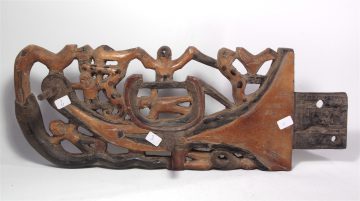
Opposite face: The chef turns his back to us
Water Spirits (mengu)?
The triangles on which are fixed cones for the accessories recall the fish with the typical eyes and the gaping mouths. (See such fish on the beak of the ship n ° 236, Kecskési 1999 p. 90/91). At the bottom behind the python a fifth man lies on his side and looks vertically into the water. His black European jacket indicates high status. His right arm is bent. The left arm – as with the Munich tang nos. 235 and 236 – cannot be seen here for carving reasons. On no. 236 („Lock Priso“) the person is stylized as a woman and – according to Kecskési – ritually emptying a sacrificial vessel for the water spirits, the mengu.
Their importance cannot be overstated for the community and individuals in the Wouri Delta. It should be added that the Jengu Water Spirit can take on a human form, but smaller in size, swim like a fish and walk straight like a human. Rather feminine, the jengu has fair skin, prominent eyes and her hair reaches to the ground, she looks like pygmies, whites and manatees. But above all she has upturned feet, which is why her footprints are easily recognizable in the sand. (René Bureau 1997, p. 54)
FIVE MOUNTED ELEMENTS TO THEME THE EXTERNAL RELATIONS
The structure on the back of the tange shows the cross section of a ship and a Chapel !
The highest structure puts a different accent compared to that of King Bell (on the right, n ° 235),which simply omits the chiefs‘ relations with the foreigners. And to that of Lock Priso (n ° 256) who integrates them critically in the context of traditional legitimacy.
The daring rural representation (left side) makes these relations the main theme in its three structures that are visible from afar. It uses the silhouette and superstructure of the German gunboat „SMS Olga“ as a model (?) and thus gains additional space to make room for new relations and meanings without the old ones totally disappearing. The adoption of Christianity is central. But I can’t help: The foreign spirits are triumphantly entering here. Highlight of the boat is the „white“ Christ, a foreign spirit. Here, the quote from René Bureau in the first part is striking: „It is the White who brought the Religion„.
Above a mighty hull, adorned with a garland of colored rhombuses (see # 256; 1999, pp. 90/91), stand two tall white men on the main deck. One arm rests on a red structure – an altar table? – which carries a „tympanum“ with a blessing Christ. Does the cloudy white layer above it mean a canopy?
„Tympanum“ is the name of a semicircular arched field above a church portal. This place becomes the center of architectural jewels of Romanesque and Gothic churches in Europe. A popular image in smaller copies is the figure of Christ flanked by saints (especially Peter and Paul). (Wikipedia.de) – Coincidence? Just an altarpiece? Where could the inspiration for this line have come from? From a church in Duala?
With the other arm, do the men lean on a suggested balustrade or rather on a stylized rum pot? Rum has been a very important barter for centuries. On the Tange of King Lock Priso (# 236), jars of rum were placed on top, while on my model, the cross tops everything. The men have large hands with serrated fingers. They stand firmly on their feet and have pronounced facial features, not to say „hard“. The foreigners as the Douala have known them for a long time.
BUT IN FRONT OF THEM – JUST ABOVE THE GIANT SNAKE FIGHTING THE BIRD – TWO DOUALA CHIEFS STAND TRIUMPHANTLY AND CARRY CHURCH GATES LIKE GIANT SNAKES .
The two „heroes“ (1999, p. 90) in early 19th century naval uniforms wear arches on their heads, just as African carriers carry loads. They hold with their oversized arms and hands two strong, black snakes, spotted with white, and press the snakes‘ heads vertically to the ground. Even the backs of their hands give the impression of strength. The snakes become transformed into the side walls of the church portal, they also change color.
By the way: The two wooden elements have rhombic handles, so they can be worn individually as a scepter.
Dimensions : 27,5 (left) / 26 cm high, 9,5 cm de large, up to 1,9 cm thick, each 60g
TWO CHRISTIAN CROSSES OR LAND SIGNS ARE MOUNTED IN THE CENTER
“Foreign and traditional elements (there) are merged” (Kecskési 1999 p.90). I can only freely fantasize about their ‚hoods‘: a red jellyfish or some other ghostly face (slanted eyes and open mouth) above? An association with the „Portuguese“ red and white crosses on the columns is more plausible. We think of the Portuguese, who were also the first Europeans in the Wouri Delta. As a „consecration cross“ in church buildings, the shape was anyway widely used in Europe, for example as a sign of blessing after construction work. And why shouldn’t the pieces also represent the two short chimneys of the SMS Olga between the first and the second mast? In any case, the two crosses serve to stabilize the construction. The rhombic supports of the signs also become handles to carry them in the hand as scepters or as “hand masks” ‘in processions as in ritual dances, whatever the symbolic meaning of the rhombic form.
REMEMBER SIXTY PERCENT OF LENGTH: THE TRADITIONAL CANOE !
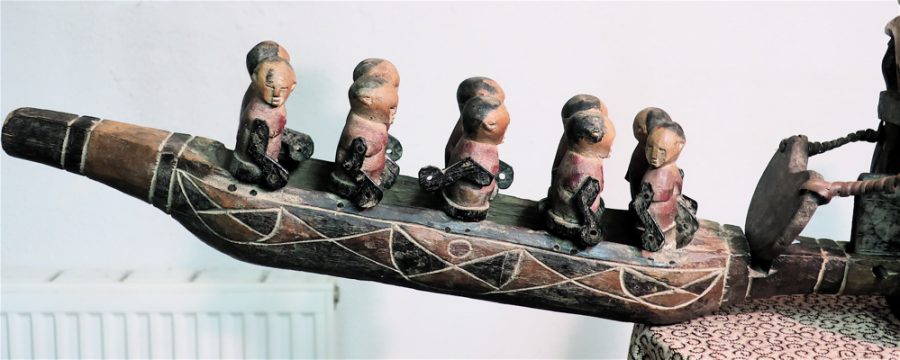 Dimensions: Hull 960 g: 62 cm long, 9 cm wide, with 15 cm high oars
Dimensions: Hull 960 g: 62 cm long, 9 cm wide, with 15 cm high oars
The compact canoe with only ten rowers tapers at both ends. Up front, technical devices allow the oversized „Tange“ to be anchored with its full image program. Since the cone visibly protrudes from the attached canoe, conservator Kerstin Frost thought of an assemblage of different boats. However, there is no space in the vertical opening of the midsection for the bow of a larger canoe. In the 33.5 cm long cavity in the hull, five rowing benches are secured from the outside with four nails each. On it sit ten movable half-figures, which end in surprisingly wide belts. Their crossed arms, which are sawn from plywood, are rotatably attached to the shoulders with nails and have a glossy black finish. The holes allow the insertion of thin leaf-shaped oars. These are hand carved and have been replaced several times. The torsos and heads of the figures are roughly cut and smoothed. The bodies are painted red and indicate nice shirts. The pectoral muscles and the upper abdomen are plastically worked out. With the belts you get the impression of individual male bodies. The heads – with the exception of two in the front row – have a remarkably broad and solid forehead. Notched ears, slit eyes, a compact nose and a compact mouth in ten different shapes suggest mental determination. The hairstyles are brushed quickly, but therefore appear individual. There is nothing more to say about this team.
Provisional Resume ( June 5 / August 8, 2020)
The dramatic allegory of the traditional chiefs of the Douala on the longitudinal plank of the Tange is enlarged by new – idealized – factors on the additional areas of the superstructures: widely accepted Christianity and the common regime with the whites.
Unlike the Lock Priso Tange (No. 216, before 1884), the main themes capture attention with their own level of representation. They relativize the attached canoe, which represents the limited indigenous military power. Oars and rowers are carefully crafted and their roles are taken seriously, but limited to their traditional role as followers of the Chief.
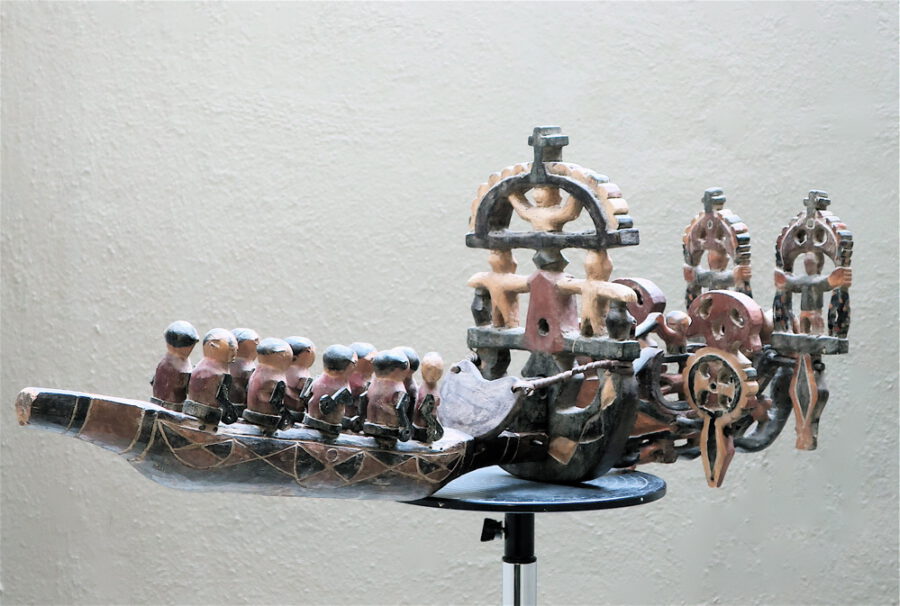 How to balance the high central construction of the Whites with the “dominant” position of the traditional chiefs in the front, that of the “snake tamers”? How to interpret the distribution of roles between partners and competitors? Will the whites be carried away together with their triumphant Christ? Confidence in the new faith is demonstrated without visible signs of shock, intimidation, or repentance. René Bureau has already underlined the practical orientation of the „conversion“ of Duala (see 1st part of the blog). Did the artist even have the shape of a gunboat like „SMS Olga“ in mind? If so, could that mean the prospect of self government of the ‚boat‘? The interpretation also depends on the moment when the object was created. The merchant’s indication “a hundred years ago” refers to the first years of Franco-British “tutelage” after 1919. The condition of the dry wood and the yellowed coats of paint would suit it perfectly. The performance would evoke a „good old days“. Merchant Maurice: „The Douala have fond memories of the Germans until today. You will find in the city of Douala the home of 100% German sailors. There is a large representation of the Germans in Douala Cameroon, even in the Maritime Museum / Maritime /… Internet can guide you on my declaration…. The Sawa community shares a lot of partnership with the Germans. “ (5.12.2019, translation)
How to balance the high central construction of the Whites with the “dominant” position of the traditional chiefs in the front, that of the “snake tamers”? How to interpret the distribution of roles between partners and competitors? Will the whites be carried away together with their triumphant Christ? Confidence in the new faith is demonstrated without visible signs of shock, intimidation, or repentance. René Bureau has already underlined the practical orientation of the „conversion“ of Duala (see 1st part of the blog). Did the artist even have the shape of a gunboat like „SMS Olga“ in mind? If so, could that mean the prospect of self government of the ‚boat‘? The interpretation also depends on the moment when the object was created. The merchant’s indication “a hundred years ago” refers to the first years of Franco-British “tutelage” after 1919. The condition of the dry wood and the yellowed coats of paint would suit it perfectly. The performance would evoke a „good old days“. Merchant Maurice: „The Douala have fond memories of the Germans until today. You will find in the city of Douala the home of 100% German sailors. There is a large representation of the Germans in Douala Cameroon, even in the Maritime Museum / Maritime /… Internet can guide you on my declaration…. The Sawa community shares a lot of partnership with the Germans. “ (5.12.2019, translation)
Nelson Nelson trafalgar Uniform flickr 2020-06-05
But is German colonial rule a problem? The rounded cut of the naval uniforms of chieftains belongs to the era long before the „contract of protection“ with the Reich, at the beginning of the 19th century (an example is Lord Nelson’s Trafalgar uniform). White Christianity first appeared in Duala in 1845. The boat display would then have historically idealized or had older predecessor objects. More questions than answers!
In the 20th century, I guess, the object has represented the legitimacy of the traditional ruler of a chiefdom, a legitimacy that has been questioned repeatedly since colonial times, particularly by ‚modern Africans‘ (ex-‚Evolués‘) in the colonial and post-colonial state apparatus to the present day. Part 2 of the blog reports on two modern generation conflicts on the outskirts of Douala. Thus the boat object – if carved for the appearance of the village chief on important occasions – is probably a document of resilience and demand of the traditional elites in Cameroon of political participation and social rule. The long-standing dispute with the “Museum Fünf Kulturen” in Munich has resulted in carefully researched studies that document, categorize and discuss the interests and arguments of an ambitious “neo-traditional leader” and ex-professor in Germany. Anne Splettstößer rates such demands for the return of so-called „insignia of rank“ to leading families as an episode in the struggle of influence in the postcolonial state of Cameroon (See: subsection 3.2 and 3.3 of her doctoral thesis.) This would be material for another blog post, as it currently crushes my possibilities. However, the three German studies mentioned below can be read and searched freely in pdf format on the Internet.
A Duala website, which propagates Ngondo festivals in Deido, shows a platform with dignitaries from the Duala / Sawa. One of them posed a shiny black figure standing in front of him – a style non-traditional in the region, but presumably in a function similar to that of my canoe model.
And really, now festival queens appear as one timely adaptation to the promotion of the Ngondo festival today. As René Bureau wrote: “The desire for tradition has also led to forms of folklore since the 1930s. After all, they give some people various positions and dignities. Traditional festivals remain sterile ”. (88-91; see 1st blog)
But is life in Africa and elsewhere – above all – a question of “spirituality”?
Bibliographical Notes
MARIA KECSKÉSI: “KUNST AUS DEM ALTEN AFRIKA” – Collections from the State Museum of Ethnology, Munich, Vol. 2, 1982: historical context and interpretations of motifs in Tange, pp.222-229 “Die Duala und ihre Boote” Catalog numbers 235, 236; pp. 232ff “Die Kunst des westlichen Kameruner Waldlandes”
MARIA KECSKÉSI: “KUNST AUS AFRIKA – Museum für Völkerkunde München” – Prestel Verlag 1999) S. 90f. Kat. 82 (= 236 oben) “Schiffsschnabel tange”
ALEXIS VON POSER (Hrsg.), Bianca Baumann (Hrsg.), Claudia Andratschke etc.: “heikles erbe – koloniale spuren bis in die gegenwart”, Lower Saxony State Museum Hanover, Sandstein Verlag Dresden 2016): About colonial collecting (with short biographies) in ethnographic collections and catalog numbers 144 – 147
ISABELLA BOSZA: „Geschenkt, gekauft, erbeutet – Missionarisches Sammeln in Kamerun und Indien”; Museum der Kulturen Basel 2019, http://www.mkb.ch/de/museum/ then at the “Fellowship” and “Forschungsbericht”, for chapters 3.1, 4., 4.3, 5.3 and 6.1
ANNE SPLETTSTÖSSER: Ein Kameruner Kulturerbe? 130 Jahre geteilte Agency: Das Netzwerk Tange/Schiffschnabel in Stefan Groth, Regina F. Bendix, Achim Spiller (Hsgb.), KULTUR ALS EIGENTUM, Göttingen University Press, 2015
ANNE SPLETTSTÖSSER : KAMERUNER KULTURERBE – Vom Umgang mit kolonialem Erbe aus Kamerun in ethnologischen Museen, Göttinger Studien zu Cultural Property, Band 15, Universitätsverlag Göttingen 2019, Dissertation, 403 S. ( als schönes Taschenbuch 40€ )
BARBARA J. HEUERMANN: DER SCHIZOPHRENE SCHIFFSSCHNABEL – BIOGRAPHIE EINES KOLONIALEN OBJEKTES UND DISKURS UM SEINE RÜCKFORDERUNG IM POSTKOLONIALEN MÜNCHEN, Münchner Institution für Ethnologie, Band 17 Working Papers in Social and Cultural Anthropology, LMU MUNICH, Vol. 17 (LINK to pdf)
2ième Atélier International de Maîtrise d’oeuvre urbaine de Douala Document du Contexte <DOUALA Ô MULEMA> Nov. 2016, www.ateliers.org, 75 pp., Pdf download images, historical city maps, geography, history, present; Portraits of the neighborhoods.
ERIC RENÉ DE ROSNY : “Die Augen meiner Ziege – Auf den Spuren afrikanischer Hexer und Heiler”, in German: Edition Trickster im Peter Hammer Verlag, Wuppertal 1999
RENÉ BUREAU : «Le peuple du fleuve – Sociologie d’une conversion chez les Douala», (Éditions KARHALA, Paris 1996), in particular chapter 1. „Sociology of the conversion of coastal people – The historical phases of conversion“. The transition to Christianity since 1843.
Schreiben Sie einen Kommentar
Ausführliche Themenliste
Schreiben Sie einen Kommentar
Ausführliche Themenliste
